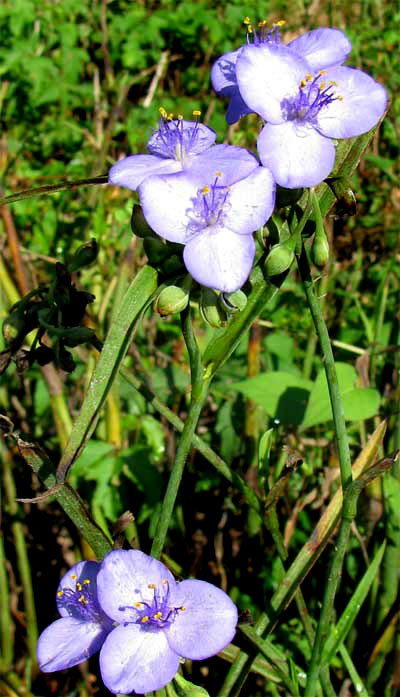Excerpts from Jim Conrad's
Naturalist Newsletter
from the July 7, 2008 Newsletter, issued from the forest near Natchez, Mississippi; elevation ~400ft (120m), ~N31.47°, ~W91.29°:
INTO A SPIDERWORT FLOWER

Along gravel roads inside Homochitto National Forest, which are not mowed or doused with herbicides like those outside, spiderworts are flowering, as shown above.
Relative to most other wildflowers, spiderwort blossoms are unusual in that they bear three petals instead of the usual four, five, or multiples thereof. That's because spiderworts are monocots, not dicots. The vast majority of wildflowers are dicots. Most monocot flowers have parts in threes, or multiples of three. Monocots and dicots are explained on my page here.
Spiderworts belong to the Spiderwort Family, the Commelinaceae. The species in the picture is the Zigzag Spiderwort, TRADESCANTIA SUBASPERA, the "zigzag" in the English name denoting the form of the stems.
It's awfully pretty down in a spiderwort's flowers, as shown below where you see a flower's six stamens rising above its single ovary, which is the pale, greenish, oval object down at the lower left. Each stamen consists of an orange-yellow anther at the top of a slender, purple filament. Anthers split open to release pollen. Though the filaments of some spiderwort species are hairless, the Zigzag Spiderwort's filaments are wooly with long, purple, segmented hairs. About 70 spiderwort species are recognized, all from the New World; Weakley's Flora of the Carolinas lists nine for the Southeast.

If you tear a spiderwort leaf or stem it bleeds a clear mucilage. Reading that the pioneers used the mucilage as glue, I tried it. Well, it does stick things together a little, but if the pioneers really used this as glue they must have been very hard up for sticky stuff.